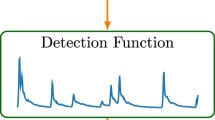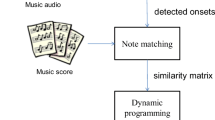Abstract
Music onset detection is significant and essential for obtaining the high-level music features such as rhythm, beat, music paragraph and structure. The traditional methods for onset detection which employ Short Time Fourier Transform (STFT)-based or Wavelet Transform (WT)-based features to characterize music signal generally lack adaptiveness for representing the stationary and non-stationary part of the music signal. This will lead to the degraded performance for music note onset detection. To solve this problem, a new algorithm for note onset detection based on sparse decomposition is proposed. Firstly, the musical signals are sparsely decomposed with Matching Pursuit (MP), and then the hybrid detection algorithm which combines namely the Degree of Explanation (DE) and the Change of Partials (CP) is applied to the sparse representation of the music signal. Finally, a modified peak-picking algorithm is employed to generate onset vectors. The experiments on the dataset with 2050 onsets show that our results are superior to those of MIREX 2013. For the polyphonic music which is the most widely used form in our real life, the proposed algorithm has better performance than the other algorithms.









Similar content being viewed by others
References
Bello JP, Daudet L, Abdallah S, Duxbury C, Davies M, Sandler MB (2005) A tutorial on onset detection in music signals. IEEE Trans Speech Audio Process 13(5):1035–1047
Bello JP, Sandler M (2003) Phase-based note onset detection for music signals. Proceedings of 28thIEEE International Conference on Acoustics, Speech, and Signal Processing (ICASSP ‘03), April 6–10, 2003
Benetos E, Simon D (2011) Polyphonic music transcription using note onset and offset detection. Proceedings of 36th IEEE International Conference on Acoustics, Speech, and Signal Processing (ICASSP ‘11), May 22–27, 2011, Prague, Czech Republic
Benetos E, Stylianou Y (2010) Auditory spectrum-based pitched instrument onset detection. IEEE Trans Audio Speech Lang Process 18(8):1968–1977
Bingkun B, Guangyu Z, Jialie S, Shuicheng Y (2013) Robust image analysis with sparse representation on quantized visual features. IEEE Trans Image Process 22(3):860–871
Daudet L (2001) Transients modeling by pruned wavelet trees. Proceedings of Computer Music Conf (ICMC‘01), at Havana, Cuba
Daudet L (2006) Sparse and structured decompositions of signals with the molecular matching pursuit. IEEE Trans Audio Speech Lang Process 14(5):1808–1816
Davy M, Godsill S (2002) Detection of abrupt spectral changes using support vector machines. Proceedings of IEEE International Conference on Acoustics, Speech and Signal Processing (ICASSP-02), at Orlando, FL
Duxbury C, Sandler M, Davies M A hybrid approach to musical note onset detection. Proceedings of Digital Audio Effects Conf. (DAFX, ‘02), at Hamburg, Germany
Fusan Z (2005) Basic music theory tutorial (revised). Shandong University Press
Goto M (2001) An audio-based real-time beat tracking system for music with or without drum-sounds. J New Music Res 30(2):159–171
Gribonval R, Bacry E (2003) Harmonic decomposition of audio signals with matching pursuit. IEEE Trans Signal Process 51(1):101–111
Holzapfel A, Stylianou Y, Gedik AC, Bozkurt B (2010) Three dimensions of pitched instrument onset detection. IEEE Trans Audio Speech Lang Process 18(6):1517–1527
Hoon H, Dooyong S, Kyogu L (2013) Note onset detection based on harmonic cepstrum regularity. Proceedings of 2013 I.E. International Conference on Multimedia and Expo (ICME2013), July 15–19, 2013, San Jose, CA
Hui LT, Yongwei Z, Chaisorn L, Rahardja S (2010) Audio onset detection using energy-based and pitch-based processing. Proceedings of 2010 I.E. International Symposium on Circuits and Systems (ISCAS2010), May 30, 2010
Jaggi S, Karl WC, Mallat S, Willsky AS (1998) High-resolution pursuit for feature extraction. Appl Comput Harmon Anal 5(4):428–449
Jia-Yin S, Hai-Feng L, Lei L (2009) ANN based music chord perception. J Tsinghua Univ Sci Tech 49(s1):1369–1374, 1379
Krstulovic S, Gribonval R (2006) Mptk: matching pursuit made tractable. Proceedings of IEEE International Conference on Acoustics, Speech and Signal Processing, (ICASSP 2006), May 14–19, 2006
Mallat SG, Zhifeng Z (1993) Matching pursuits with time-frequency dictionaries. IEEE Trans Signal Process 41(12):3397–3415
Masri P (1996) Computer modeling of sound for transformation and synthesis of musical signal. Univ. of Bristol, Bristol
Pertusa A (2010) Computationally efficient methods for polyphonic music transcription. PhD Thesis. Universidad de Alicante
Ravelli E, Richard G, Daudet L (2008) Union of MDCT Bases for audio coding. IEEE Trans Audio Speech Lang Process 16(8):1361–1372
Rodet X, Jaillet F (2001) Detection and modeling of fast attack transients. Proceedings of the Computer Music, at Havana, Cuba
Wenming G, Xi S, Ruifan L (2011) A new algorithm for note onset detection. Comput Eng Appl 47(24):9–11
Xiangbin S, Ming L, Jiehong W, Lin Z (2010) An improved onset detection algorithm. Proceedings of the International Conference on Internet Technology and Applications, Aug. 20–22, 2010
Yanan F, Qiang L, Xin G (2011) Entropy of teager energy in wavelet-domain algorithm applied in note onset detection. Proceedings of Seventh International Conference on Natural Computation (ICNC2011), July 26–28, 2011
Acknowledgments
This work is supported by the National Nature Science Foundation of China under Grant No. 60902065, No. 61401227, and by Beijing Natural Science Foundation(No.4152053).
Author information
Authors and Affiliations
Corresponding author
Rights and permissions
About this article
Cite this article
Shao, X., Gui, W. & Xu, C. Note onset detection based on sparse decomposition. Multimed Tools Appl 75, 2613–2631 (2016). https://doi.org/10.1007/s11042-015-2656-8
Received:
Revised:
Accepted:
Published:
Issue Date:
DOI: https://doi.org/10.1007/s11042-015-2656-8




